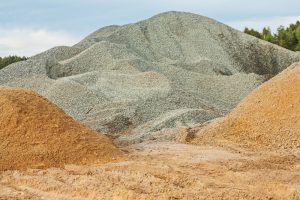“Sands, unbroken by mosque or minaret,
Unstruck by tower or battlement;
Sands, endless, unbounded, eternal;
Sands, quivering with reflected heat,
Undulating as waves upon a frozen sea,
Conjoining the sky in a coppered haze
Where monstrous demons, sight-conjured,
Tread reelingly a dance of sun desire,
Twisting and turning in a burning maze,
Tireless, grotesque, sinister.”
Desert
by Arthur Crew Inman
Next to water, sand is the most used natural resource by humans. – earth.org
You’d find it everywhere. In buildings, smartphones, glass, on the beach, desert, and even as an unwanted and often swept away house guest.
But the world is running out of sand.
Pretty strange for a commodity found almost everywhere and covering an estimated 29% of the earth’s surface according to phys.org. However, this isn’t the type of sand we need. Not all sand is useful sand, at least not to humans.
The kind of sand we need is not desert gold sprawling the Sahara, as pretty as it might seem. Wind erosion and harsh exposure make it the wrong shape and kind. It’s far too smooth and rounded to bind together for construction.
The kind of sand is a smoother type with smaller particles and high portions of silt. It helps it hold the right amount of water and also serves as a good binder. To get the kind of sand we need, we have to drill beds, banks, floodplains of lakes, rivers, seashores, farmlands, beaches, and forests. Unfortunately, centuries of depleting these resources have led to a global crisis.
There is an estimated global consumption of approximately 40 to 50 billion tons of sand annually, and that demand has created an illegal mining system of sand globally.
According to earth.org, a global environmental data journalism organization,
Rapid urbanization and a growing number of behemoth infrastructure projects have spiked demand for sand, especially in developing countries, and a handful of nations are already running out of it. Vietnam might run out of sand as early as 2022.
An Anthropogenic Biosphere study by Environmental scientist Erle Ellis shows that “three centuries ago, humans were using just around 5 percent of the planet, with nearly half the world’s land effectively wild. Today, more than half of Earth’s land is occupied by agriculture or human settlements.”
The growth, expansion, and movement of people create massive amounts of construction sand. Concrete is currently the leading choice for construction. For its production, a ton of cement requires six to seven tons of sand. The global sand market is continuously affected by supply and demand imbalances. 300 years later, humanity has grown massively and continues to increase. It is estimated that 54% of the world’s population lives in urban areas and, come 2050, that number is assumed to reach 66%.
Between 2011 and 2014, China used more sand than the US did in the entire 20th century. The nation’s biggest dredging site at Lake Poyang produces 989,000 metric tons of sand per day.

Its construction boom consumes half the world’s supply of sand. Artificial islands in the South China Sea with military bases and the Belt and Road Initiative require much more sand than it currently consumes. The country has laid down 146,000 km of new highways in a single year.
Singapore has increased its land area by 20 percent since the mid-1960s using large quantities of Indonesian and Malaysian marine sand. Further down east, projects like Dubai’s Palm Jumeirah or World Island developments are a major culprit. The economic boom and development in Asia and Africa mean a larger demand for sand.
Sand mining poses a danger to human settlements. For communities already vulnerable to floods, storms, and erosion, it creates an increased danger for them.
Recent research has also shown that mining activities are killing and posing a grave danger to vulnerable animal species, including fish, crabs, dolphins, and crocodiles. There is no faster way to take out civilization (and by extension humans) other than destroying water sources for humans and animals. Our appetite for big construction is at the cost of agriculturally dependent communities.
Sand accounted for 85% of the total weight of mined material in 2014, yet it takes thousands of years of rock erosion to replenish. To give more perspective, data published by USGS.gov | Science for a changing world states that to maintain our standard of living, each person in the United States requires over 40,630 pounds of minerals each year and of that figure, 7,254 pounds is sand and gravel right after stone of which they require 10,765 pounds.
The issue of sand mining is also political. Although some countries and communities have legislation guiding sand mining, there are currently no international laws regulating the global mining, use, and trade of sand. As a result, in multiple countries, sand mining has become a criminal enterprise resulting in murders and theft. The illegal extraction of the river and coastal sand has been reported in as many as 70 countries.
In the US, sand mining for fracking has tarnished areas of Wisconsin. In the UK, Friends of the Earth has been fighting a long battle to curb sand dredging on Lough Neagh in Northern Ireland, one of Europe’s most important wetlands.
In Morocco, it is reported that an estimated half of the country’s annual extraction comes from illegal mining. In India, there are reports of murders in local communities. In Singapore, one of the world’s importers of sand, Indonesia, Vietnam, and Malaysia have imposed limits or temporary bans on them, forcing Singapore to turn to other countries for sand.
Another great and not-so-talked-about consumer of sand is the tourism industry. The key elements of tourism are known as the 5 As Access, Accommodation, Attractions, Activities, and Amenities. Aside from Access, to have Accommodation, Attractions, and Activities, mostly demands construction, and cities are in a race to create the 5As. A good example is Dubai. It was completely transformed by constructing the world’s tallest building to man-made islands in the shape of a world map, and other ambitious islands targeted at tourists. That transformation has made it one of the most visited locations in the world in recent times.
To deal with the future of tourism, countries will be looking for new activities to bring people back. That might lead to more consumption of sand to create new attractions.
What can be done?
First, we need to take a sustainable approach to sand. How much sand are we going to need in the future, where will it come from and why do we need it?
Figuring out those questions will help structure better policies to guide the use of sand and also encourage sustainable alternatives.
Current research shows that recycled plastic, earth, bamboo, wood, straw, and other materials can be used as alternative building materials. It might seem like that might be in the distant future but, a company in Portland, Oregon recently built a very first-of-its-kind high skyscraper using wood.
The key seems to be to blend other materials with the all-encompassing concrete to give the mixture the necessary stability for a building.
Recycled plastic has the potential to become a serious alternative to sand in road building. Multiple countries have already been experimenting with plastic composite roads. Plastic waste can replace 10% of the natural sand in concrete, saving at least 800m tonnes per year. Plastic roads are estimated to be three times more durable than traditional asphalt roads. Plastic Roads — Design Life-Cycle
However, they are still in their testing phase as their longevity, as well as their environmental impact, need to be studied further: small particles of the plastic could eventually find their way into the soil and water through heat, wear and tear, and run-off.”
Ultimately, our resources are not infinite. Finding and using sustainable alternatives where necessary will help protect the planet and millions of lives.


